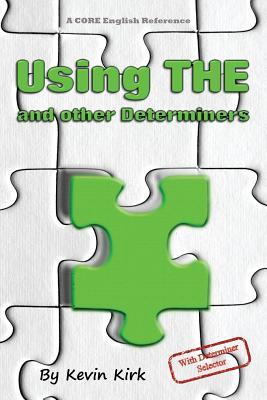Of all of the different types of words in English, people have the most trouble using articles, in particular the definite article 'the'. Most grammar books provide a series of rules that you are expected to learn. These 'rules' are further complicated by the number of exceptions to each of these rules, many of which can change within the same sentence; leaving you to guess whether to use it or not.
This book takes a different approach. For a start, it isn't a grammar book, where you are expected to work your way linearly through the text in order to find what you want; instead, it is a reference book, somewhat like a dictionary but in more depth, with a very comprehensive table of contents that allows you to find exactly what you need to know quickly and efficiently. It also offers full explanations of articles and determiners such as: how to recognise them, how to use them with other parts of speech, how to interchange them and what they are used for.
Furthermore, it doesn't apply a 'broad brush' approach to the objects of the determiners; instead, it lists around 400 different categories of object nouns with the rules for each. Together with the rules for each object it also lists the exceptions to those rules pertaining to that specific object. These are further categorized into groups - such as places, people, animals, phenomena, food etc. - to make the subjects easier to find. So when you want to know whether to use 'the' or not in a sentence you merely have to quickly look it up instead of having to memorise the rules. Every rule, exception and comment in the book is accompanied by sample sentences so you can see the rule in action.
In addition to 'the' and the other articles (a, an, some and any) it also lists the other 100 determiners, including compound determiners (for example 'a little bit of' or 'some of the'), which you can use to add nuance and impart the exact meaning to your sentences. This section also tells you what type of subject each one would be used for (for example nouns, adjectives or pronouns), together with comprehensive notes and multiple examples to show you exactly how to use the determiner in your work. There are also directions as to whether to use the determiner with singular or plural objects, the number of objects being referred to, whether the object is countable or uncountable, whether it applies to abstract or concrete nouns (or both) and what type of verb to use with it. The determiner's pronunciation, in IPA format, is also provided. Pronunciation is an important component of CORE and so a comprehensive set of pronunciation exercises are also provided, complete with the relevant IPA symbols.
There is also a new methodology (CORE) explained that will allow you to create grammatically correct sentences using your contexts and experiences. Using this method, you can exchange one type of determiner (such as the) for another (such as a compound determiner like 'many of the') in order to focus your writing.
Finally, in order to help you to find exactly the right determiner to use there is a comprehensive determiner selector at the back of the book, which you can use to choose exactly the right word or phrase.
